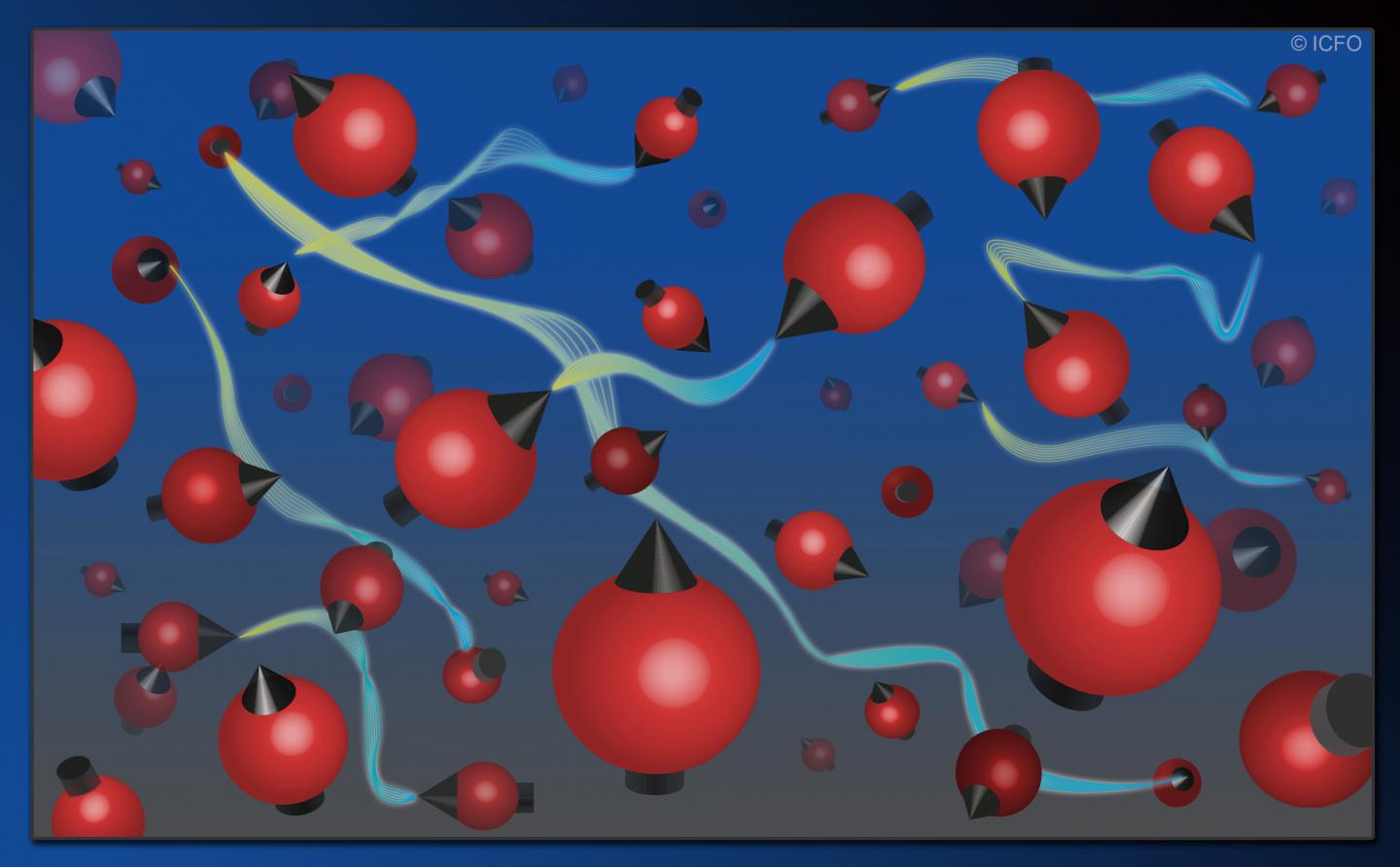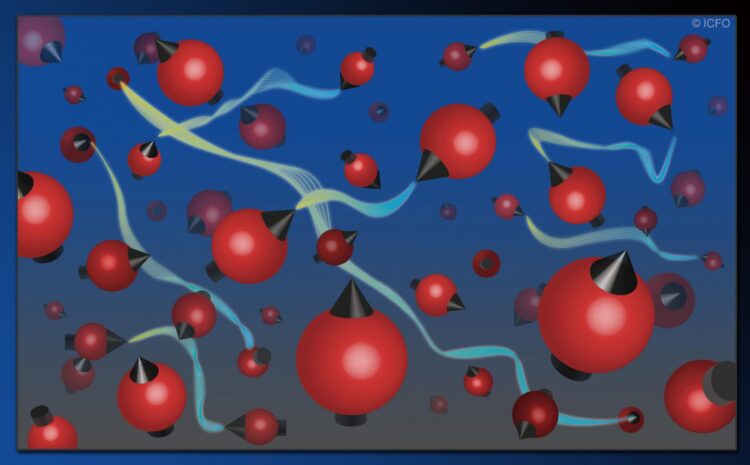
Credit: ICFO
Quantum entanglement is a process by which microscopic objects like electrons or atoms lose their individuality to become better coordinated with each other. Entanglement is at the heart of quantum technologies that promise large advances in computing, communications and sensing, for example detecting gravitational waves.
Entangled states are famously fragile: in most cases even a tiny disturbance will undo the entanglement. For this reason, current quantum technologies take great pains to isolate the microscopic systems they work with, and typically operate at temperatures close to absolute zero. The ICFO team, in contrast, heated a collection of atoms to 450 Kelvin, millions of times hotter than most atoms used for quantum technology. Moreover, the individual atoms were anything but isolated; they collided with each other every few microseconds, and each collision set their electrons spinning in random directions.
The researchers used a laser to monitor the magnetization of this hot, chaotic gas. The magnetization is caused by the spinning electrons in the atoms, and provides a way to study the effect of the collisions and to detect entanglement. What the researchers observed was an enormous number of entangled atoms – about 100 times more than ever before observed. They also saw that the entanglement is non-local – it involves atoms that are not close to each other. Between any two entangled atoms there are thousands of other atoms, many of which are entangled with still other atoms, in a giant, hot and messy entangled state.
What they also saw, as Jia Kong, first author of the study, recalls, “is that if we stop the measurement, the entanglement remains for about 1 millisecond, which means that 1000 times per second a new batch of 15 trillion atoms is being entangled. And you must think that 1 ms is a very long time for the atoms, long enough for about fifty random collisions to occur. This clearly shows that the entanglement is not destroyed by these random events. This is maybe the most surprising result of the work”.
The observation of this hot and messy entangled state paves the way for ultra-sensitive magnetic field detection. For example, in magnetoencephalography (magnetic brain imaging), a new generation of sensors uses these same hot, high-density atomic gases to detect the magnetic fields produced by brain activity. The new results show that entanglement can improve the sensitivity of this technique, which has applications in fundamental brain science and neurosurgery.
As ICREA Prof. at ICFO Morgan Mitchell states, “this result is surprising, a real departure from what everyone expects of entanglement.” He adds “we hope that this kind of giant entangled state will lead to better sensor performance in applications ranging from brain imaging to self-driving cars to searches for dark matter.”
A Spin Singlet and QND
A spin singlet is one form of entanglement where the multiple particles’ spins–their intrinsic angular momentum–add up to 0, meaning the system has zero total angular momentum. In this study, the researchers applied quantum non-demolition (QND) measurement to extract the information of the spin of trillions of atoms. The technique passes laser photons with a specific energy through the gas of atoms. These photons with this precise energy do not excite the atoms but they themselves are affected by the encounter. The atoms’ spins act as magnets to rotate the polarization of the light. By measuring how much the photons’ polarization has changed after passing through the cloud, the researchers are able to determine the total spin of the gas of atoms.
The SERF regime
Current magnetometers operate in a regime that is called SERF, far away from the near absolute zero temperatures that researchers typically employ to study entangled atoms. In this regime, any atom experiences many random collisions with other neighbouring atoms, making collisions the most important effect on the state of the atom. In addition, because they are in a hot medium rather than an ultracold one, the collisions rapidly randomize the spin of the electrons in any given atom. The experiment shows, surprisingly, that this kind of disturbance does not break the entangled states, it merely passes the entanglement from one atom to another.
###
Reference: 10.1038/s41467-020-15899-1
ABOUT ICFO
ICFO was founded by the Government of Catalonia and the Universitat Politècnica de Catalunya (UPC), both of which are members of its board of trustees along with the Cellex and Mir-Puig Foundations, philanthropic entities that have played a critical role in the advancement of the institute. Located in the Mediterranean Technology Park in the metropolitan area of Barcelona, the institute currently hosts 400 people, organized in 25 research groups in 60 state-of-the-art research laboratories. Research lines encompass diverse areas in which photonics plays a decisive role, with an emphasis on basic and applied themes relevant to medicine and biology, advanced imaging techniques, information technologies, a range of environmental sensors, tunable and ultra-fast lasers, quantum science, photovoltaics and the properties and applications of nano-materials such as graphene, among others. In addition to two state awarded Severo Ochoa accreditations of excellence, ICFOnians have secured 15 ICREA Professorships and 37 European Research Council grants. ICFO is proactive in fostering entrepreneurial activities, spin-off creation, and creating collaborations and links between industry and ICFO researchers. To date, ICFO has helped create 7 start-up companies.
About HDU
Hangzhou Dianzi University is located in Hangzhou, one of the most dynamic cities in the Yang-tse River Delta area and the capital city of Zhejiang Province, one of the most prosperous provinces in China with strong economic growth, vitality and potential. Hangzhou Dianzi University (HDU) was founded in 1956. It is a comprehensive university and one of the best top 5 universities with its own distinctive features in the field of electronic science and technology, engineering and information technology as well as management and accounting,etc. HDU has over 25000 students and more than 2300 staff members. It has 21 schools and research institutes which offers 59 undergraduate programs, 93 postgraduate programs and 6 PhD programs in science, engineering, management, economics, literature, law, education and art, along with multiple interactive disciplines and specialties. HDU has successfully established partner relationships and developed many kinds of international cooperative programs with more than 90 universities and institutes all over the world, including USA, Canada, Mexico, Russia, Belarus, UK, Ireland, France, Germany, Spain, Italy, Sweden, Australia, Japan, etc.
Media Contact
Alina Hirschmann
[email protected]
Related Journal Article
http://dx.





